Key takeaways:
- Recognizing energy waste through daily habits, such as leaving devices plugged in or lights on, can significantly impact energy consumption.
- Identifying major energy consumers in the home, like HVAC systems and kitchen appliances, is crucial for reducing waste and costs.
- Implementing energy-efficient appliances, like Energy Star-rated models and LED bulbs, leads to both financial savings and a positive environmental impact.
- Monitoring energy usage through apps and regular bill reviews fosters accountability and encourages more intentional consumption habits.
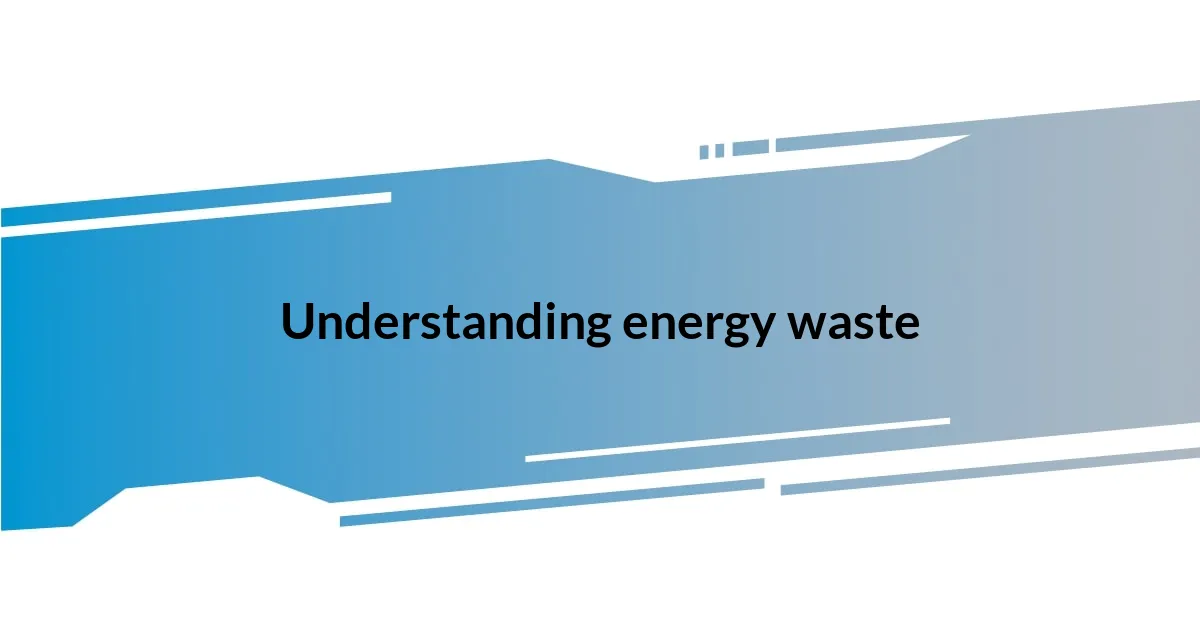
Understanding energy waste
Understanding energy waste starts with recognizing how often we leave devices charging longer than needed or forget to turn off lights in unoccupied rooms. I’ve had those moments where I walk past a lit room, and it hit me—why am I wasting energy when flicking a switch could make a difference? Each tiny action contributes to a larger issue, and many of us remain oblivious to our personal habits.
I remember the day I finally checked our utility bill and was shocked at how high it was. It made me think: how many appliances are running silently in the background, consuming power? The irony struck me hard—despite the care I thought I took, I was inadvertently supporting energy waste just by being careless about daily habits.
When I think about energy waste, the scale can feel overwhelming. Does it really matter if I leave my phone charger plugged in just overnight? The numbers say it does! I realized that eliminating waste isn’t just about being eco-friendly; it’s about taking control of my choices and making a conscious effort to be more responsible.
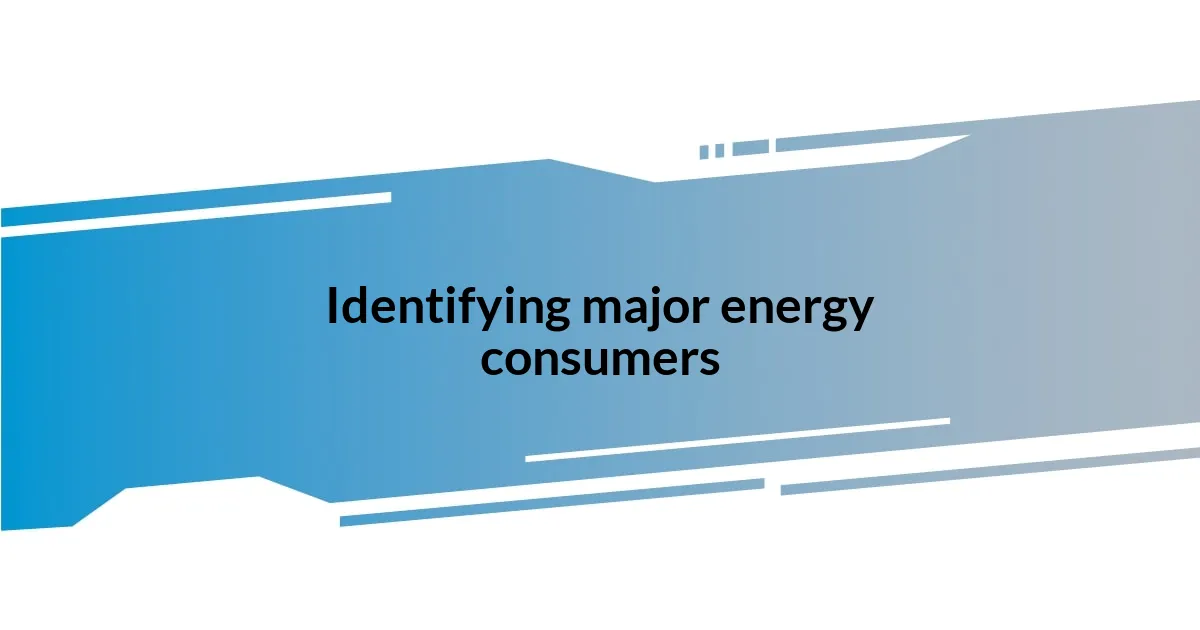
Identifying major energy consumers
Identifying the primary energy consumers in my home was a real eye-opener. I decided to take a journey through each room, assessing the devices plugged in and their corresponding energy usage. It was surprising to find that my television, often left on during family gatherings, wasn’t just a source of entertainment but also a significant energy hog. I quickly learned that running a large appliance like that for just a few extra hours can lead to noticeable spikes in my energy bill.
It’s often the hidden energy users that get us. For instance, I used to overlook my kitchen appliances when not in use. Our toaster oven, while convenient, was often left on for longer than necessary, consuming energy even as we waited to eat. A little awareness and intentionality go a long way, and I’ve since started turning it off right after I’m done.
When I turned my attention to HVAC systems, I discovered they were largely responsible for heating and cooling my home. Did you know that outdated systems could double or triple energy consumption? I was astounded when I realized how embracing a programmable thermostat could help me cut down energy use, especially when no one was home. Taking these steps isn’t just about reducing costs; it’s about embracing a more sustainable lifestyle.
| Energy Consumer | Approximate Energy Usage (kWh/month) |
|---|---|
| Television | 60-120 |
| HVAC System | 400-800 |
| Kitchen Appliances (Toaster Oven, Microwave) | 60-180 |
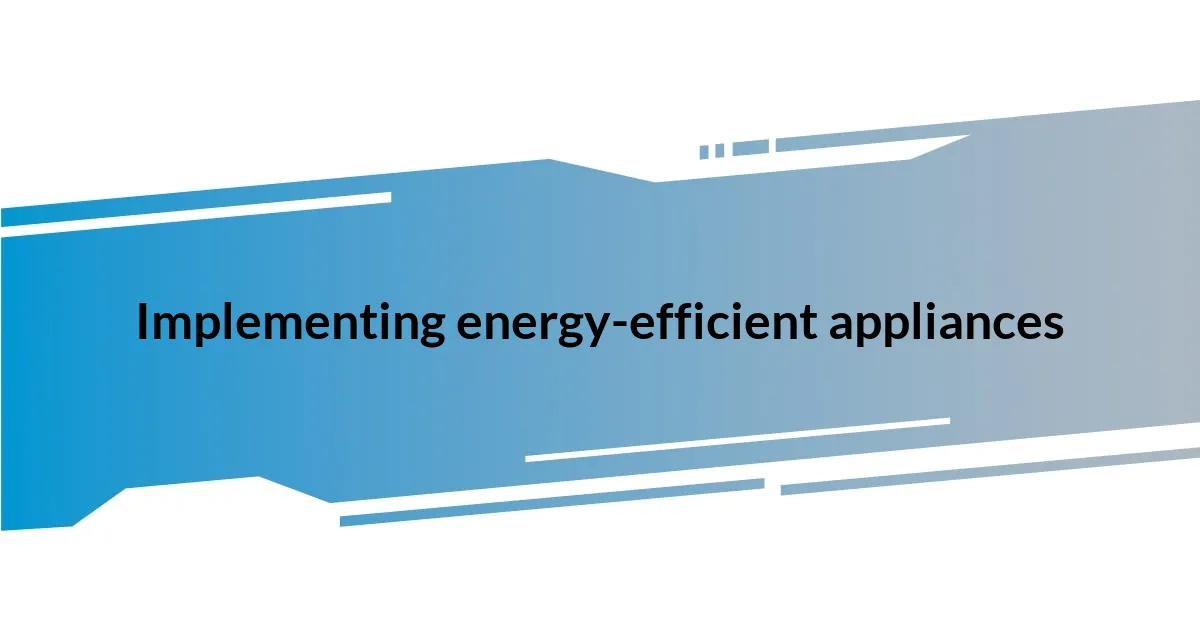
Implementing energy-efficient appliances
Implementing energy-efficient appliances has truly changed my approach to managing energy use at home. When I decided to replace our old refrigerator, the difference was striking. I remember standing in the appliance store, overwhelmed by options, but choosing an Energy Star-rated model filled me with a sense of purpose. The savings on my monthly bill were evident, but what excited me most was knowing I was making a positive impact on the environment with each cold snack.
Among the standout appliances I’ve embraced are:
- Energy-efficient washers and dryers—They use less water and energy for each load while still delivering high performance.
- LED light bulbs—These last longer and consume significantly less electricity compared to traditional bulbs, providing a win-win for both my wallet and the planet.
- Low-flow showerheads—They not only cut down water usage but also reduce the energy needed to heat the water, all while maintaining a satisfying shower experience.
- Smart thermostats—I programmed mine to adjust temperatures automatically when I’m gone, which has made a noticeable difference.
Nicknamed “the savings champ” by my family, our new energy-efficient appliances have not only helped reduce waste but have also made me feel like I’m guiding my household toward a more sustainable future. Each time I pass by the fridge, I pop a little grin, knowing that every choice I make can contribute to a greener world.
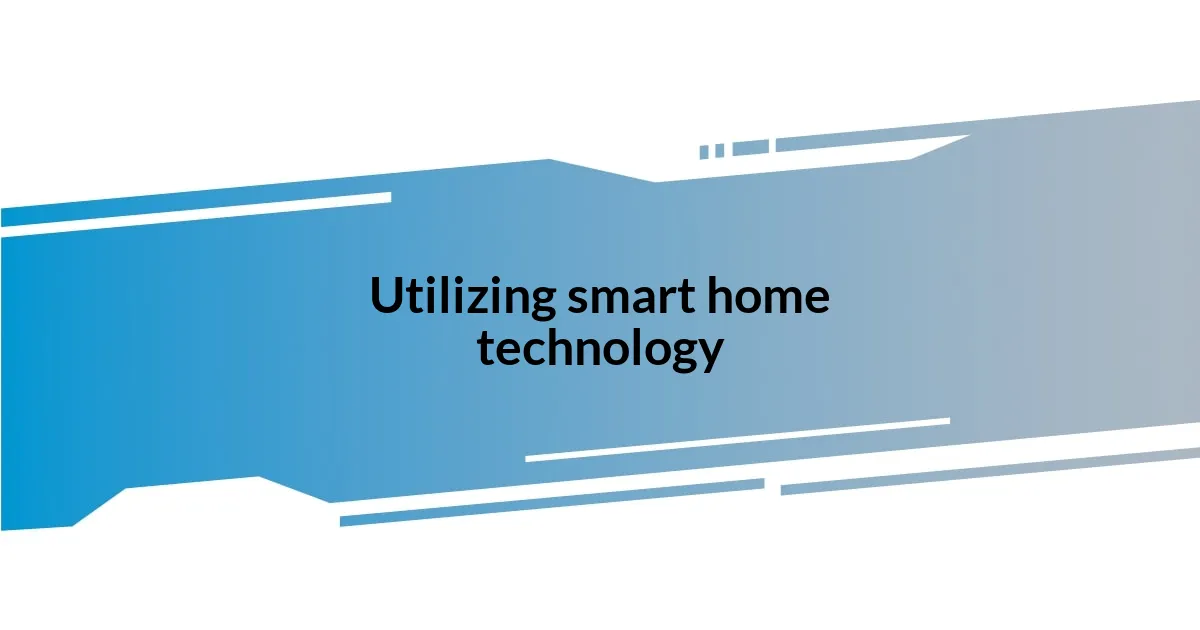
Utilizing smart home technology
Utilizing smart home technology has revolutionized the way I approach energy efficiency. I vividly recall the day I installed smart plugs. With the tap of an app, I could turn off devices that I often forgot were still running, like our living room lamp or the coffee maker. It felt empowering to know I had control over these sneaky energy drains, all from the palm of my hand—who wouldn’t want that?
Another game-changer for me has been integrating smart thermostats into my home. I hesitated initially, thinking it was too complicated, but once I got the hang of it, I wondered why I hadn’t done it sooner! The thermostat learns my schedule and adjusts the temperature accordingly, helping me save energy when the house is empty. It’s amazing how much more comfortable my home feels, knowing I’m doing my part to reduce waste without having to worry about constant temperature adjustments.
Having a smart home hub has become essential for managing everything seamlessly. I remember the first evening I set up routines, like dimming the lights and lowering the thermostat when it’s movie night. Instead of juggling multiple remotes and switches, I felt as if I was stepping into the future! Not only did these adjustments save energy, but they turned simple activities into sustainable rituals. How could I not feel a sense of pride every time I made smart living choices? Those little victories have not only lightened my energy load but have also inspired my family to be more conscious about consumption.
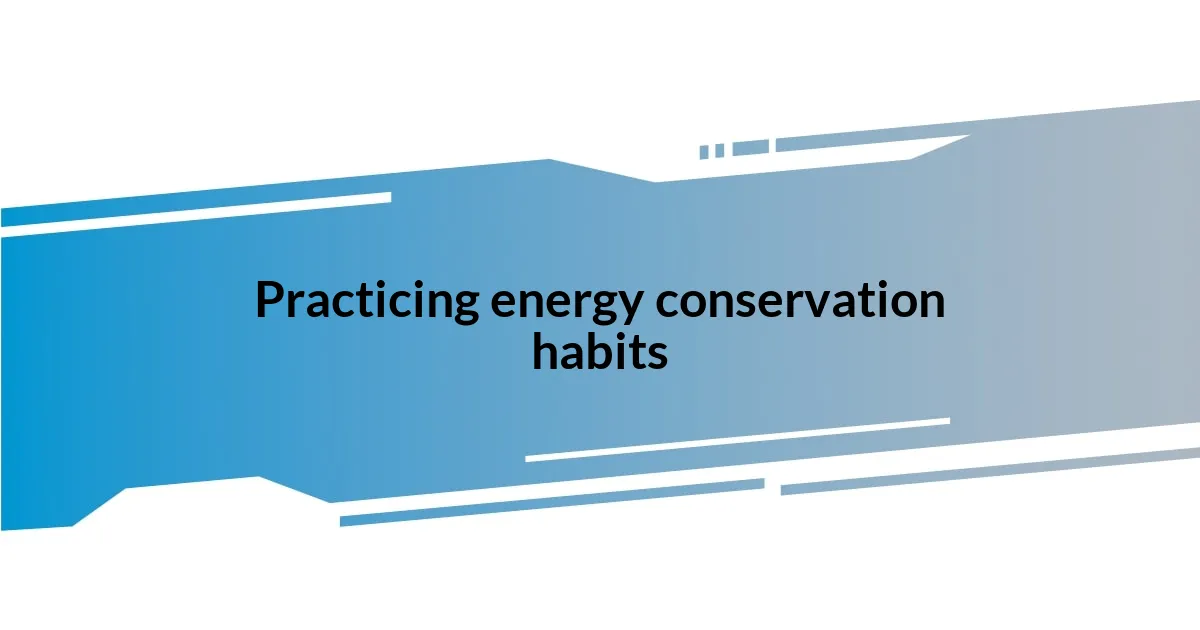
Practicing energy conservation habits
Adopting energy conservation habits has been a gradual but rewarding journey for me. I started by systematically turning off lights in rooms that weren’t in use. I recall one evening, standing in the kitchen, leaving the light on while I moved to the living room. It hit me then: it only takes a second to make a small difference, and now, I have a mental checklist that includes switching off lights every time I leave a room. It’s a small habit that’s become second nature, and it feels great to know I’m doing my part.
One practice that has significantly reduced my energy consumption is unplugging devices when they’re not in use. I remember having a phone charger plugged in that was just sitting there, silently consuming energy. It was an eye-opener to realize these “phantom loads” could add up on my electric bill. Now, I’ve made it a routine to unplug chargers and appliances, which not only conserves energy but also keeps my space tidy. Have you ever considered how much energy you might waste without realizing it? It’s surprising how these little things accumulate over time.
Lastly, I’ve found that being mindful of my laundry habits plays a crucial role in conserving energy. I’ve set a rule to only do laundry when I have a full load. I can’t tell you how much of a game-changer this became after one particularly busy week—when I was tempted to wash a single item. I paused and thought about the energy and water I’d waste. Instead, I waited, and by the end of the week, felt a sense of pride using the washer only when it counted. It’s those moments of intentionality that not only lighten my ecological footprint but also give me a palpable sense of accomplishment.
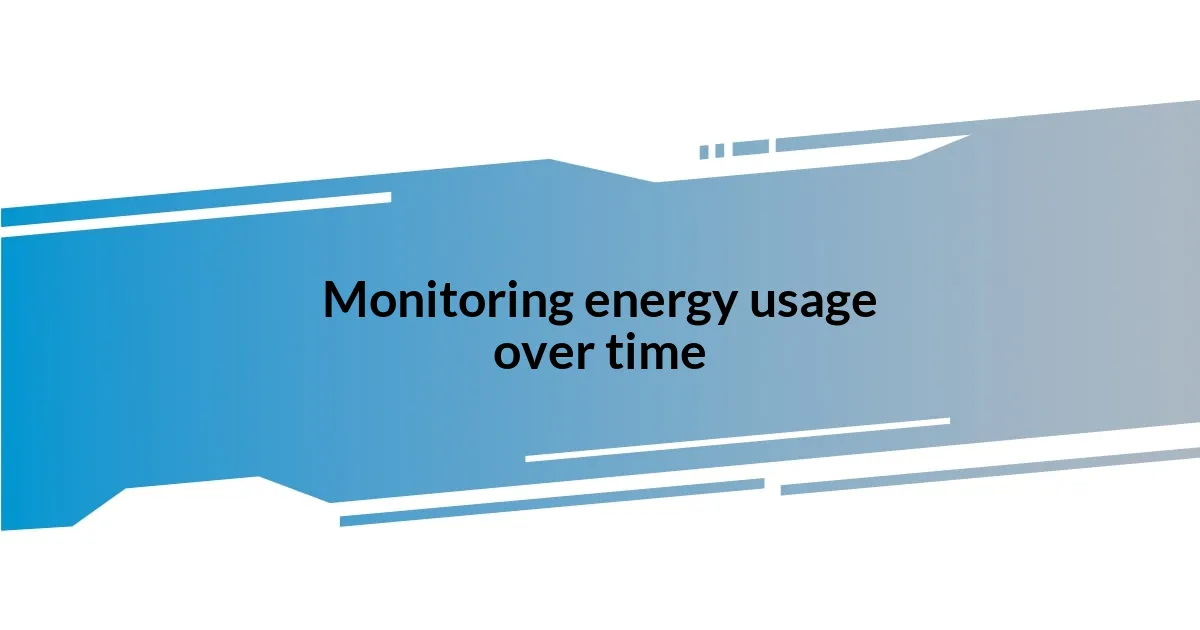
Monitoring energy usage over time
Monitoring my energy usage over time has been an enlightening experience. I’ve embraced the use of energy monitoring apps that track my consumption patterns, and it’s fascinating to see how different activities affect my electricity usage. One evening, I decided to check the app during dinner prep and was shocked to find that the oven, microwave, and dishwasher were running simultaneously. It made me rethink how I approach cooking. Have you ever considered how small changes in routine can lead to big savings?
Regularly reviewing my energy statements has also been a revelation. I remember opening my monthly bill and immediately zeroing in on the spikes compared to previous months. I started taking notes and noticed that the highest consumption coincided with extra appliance use during a recent family gathering. This simple insight prompted me to plan ahead for future events—perhaps utilizing a slow cooker to keep dishes warm rather than relying on the oven. Isn’t it remarkable how awareness can directly lead to more intentional energy use?
I’ve even started to compare my monthly usage with that of the previous year to identify trends. It’s motivational to see the positive impact of my efforts reflected in the numbers. One month, I celebrated a noticeable decrease, and honestly, it felt like a small victory. Tracking these changes not only helps in reducing energy waste but also builds a sense of accountability and achievement. How do you keep track of your own energy consumption? It can really transform the way you perceive and engage with your habits.
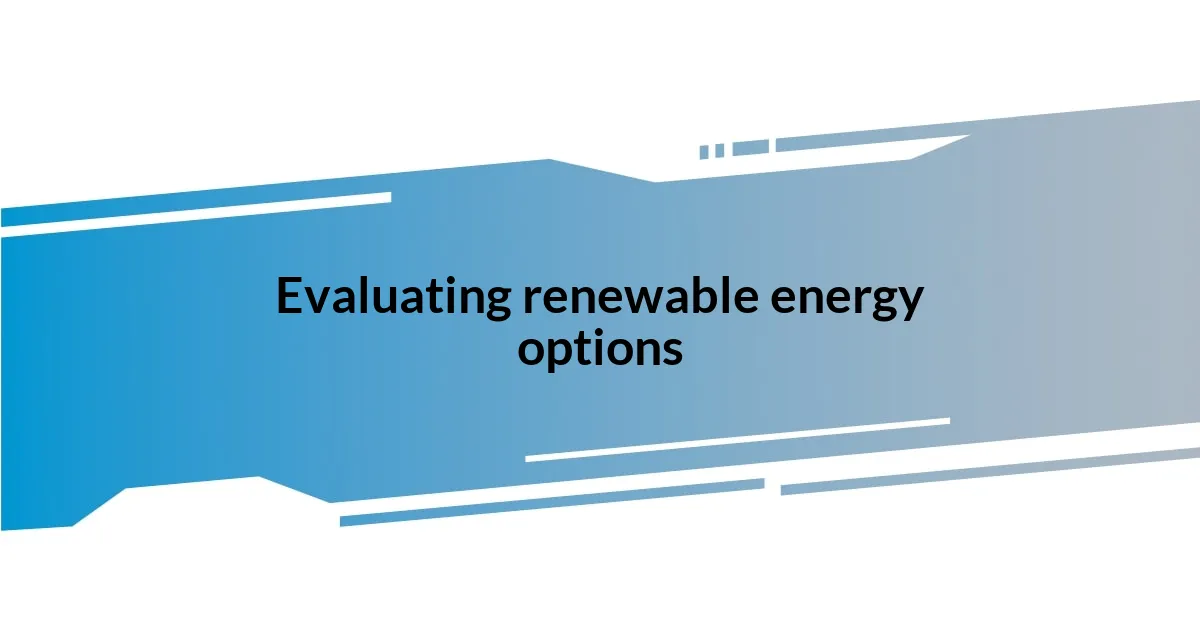
Evaluating renewable energy options
When evaluating renewable energy options, I often reflect on the decision to install solar panels at my home. Initially, the idea seemed daunting, but the prospect of generating my own electricity felt empowering. After researching various systems, I realized that the long-term savings and decrease in my carbon footprint outweighed the upfront costs. Have you ever considered how investing in renewable energy can transform not just your energy bills but your entire living space?
Wind energy is another intriguing option I’ve explored. A friend installed a small turbine in their backyard and raves about the newfound independence from conventional power sources. I remember visiting and being impressed by how quiet and unobtrusive it was, yet it generated enough energy to power their home for much of the year. It got me thinking about the possibilities—how could such a solution fit into my own lifestyle?
Lastly, exploring geothermal heating opened my eyes to the ingenuity of renewable energy sources. I came across a local company offering geothermal systems, which use the stable temperature of the earth to regulate indoor climate. It struck me how such technology could substantially reduce reliance on traditional heating methods. Just imagine, a cozy home in winter without the steep heating bills! Evaluating these options really made me feel like I was stepping towards a more sustainable future. It’s fascinating to think about which solution might resonate with you the most.